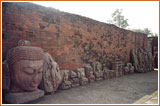Ratnagiri Tour

Ratnagiri, the jewel hill, is in the Jaipur district of Orissa. It lies near to the river called Brahmin. Ratnagiri Situated 65 kms northeast of Cuttack, but just 5 kms from Khandagiri & Udayagiri is Ratnagiri, one of three ancient Buddhist universities of yore. Ratnagiri is one of the famous Buddhists Centre in India. The small hill near the village of the same name has rich Buddhist antiquarian remains.
A large scale excavation in the town has unearthed two big monasteries, one big stupa, Buddhists shrines, sculptures and votive stupas in bundles. The site also yielded a rich crop of antiquities. Particularly noteworthy are the bronze and stone images of the Buddha and a host of idols of the Buddhist pantheon. A large head of the Buddha found on top the hill indicates the colossal nature of the original images. This excavation has revealed its relation with the Gupta dynasty which dates back on 6thcentury AD. Initially Ratnagiri was an important Centre of the first form of Buddhism, Mahayana. Later during the 8th-9th century A.D., this became a major Centre of Tantric Buddhism or Vajrayana art and philosophy. Apart from a religious Centre, Ratnagiri was an important Centre of learning for the Tantric Buddhism or Vajrayana.
Modern-day Orissa has inherited the Buddhist heritage that was nurtured by ancient Kalinga, a land as sacred as Lumbini and Sarnath for Buddhists. One gets transfixed by the remains of the Buddhist monuments in Orissa, and Ratnagiri is one of them. The Buddhist tourist trail in Ratnagiri makes it clear how some of the remarkable places, with so much sculptural value, have withstood the ravages of time.
A Tibetan source, 'Pag- Sam-Jon-Zang', indicates that the institution at Ratnagiri played a significant role in the emergence of the 'Kalachakra Tantra' during the 10th century A.D. This is quite evident from the numerous votive stupas with reliefs of divinities of the Vajrayana pantheon. Separate images of these divinities and inscribed stone slabs and moulded terracotta plaques with 'dharanis' found in the excavation at Ratnagiri.
A large brick monastery with beautiful doorways, cella, sanctum with a colossal Buddha figure and a large number of Buddhist sculptures are the magnificent ruins offered by Ratnagiri. There is a smaller monastery at the place along with a stone temple, brick shrines and a large stupa with numerous smaller stupas around.
There is one more Ratnagiri in India which is in the State of Maharashtra, but this Ratnagiri is in the state of Orissa and is Ratnagiri way of the beaten path. Serious students of Buddhism should be delighted with the enigmas of little-known gem of Ratnagiri.
The story connected. It is stated in the Datavamsa (an early and authentic Buddhist text from Sri Lanka) that it was at Ratnagiri that the relics of the Buddha were temporarily kept while they were being shifted from Dantapuram, the capital of Kalinga, or ancient Orissa, to Anuradhapura in Sri Lanka.

According to the text, soon after the Buddha's Mahaparinirvana, the Great Cessation at Kushinagar, his left canine was carried to Kalinga by one of his close disciples Khema Thera, and was presented to its king, Brahmadatta. Brahmadatta had constructed a grand chaitya (the Buddhist prayer hall) in the heart of his capital Dantapura. The chaitya that had enshrined the relic is worked upon in gold and lustrous gems.
Brahmadatta religiously offered his tribute and obeisance to the chaitya, a practice that was continued during the respective rules of his son Kasiraja, and grandson Sunanda. A few centuries later, Guhasiva, the king of Kalinga paid further tribute to the relic and made a series of attempts to extend its popularity outside his political dominion.
Guhasiva is said to have ruled during the 3 rd century A.D as a subordinate of Pandu, the King of Pataliputra, who was a diehard Jaina, and a Brahmanical and Buddhist heretic. Pandu's hostile attitude towards these religions did not augur well for Guhasiva, who was a Buddhist. So, Guhasiva enshrined the sacred tooth relic in a gold casket placed upon a chariot, and offered it to Pandu amidst much fanfare. After gazing at the miraculous bright light the relic emanated, Pandu gave himself up completely to Buddhism. Relieved of his fear, Guhasiva came back to the capital with the relic.
Word about the miraculous light of the tooth relic spread in the contemporary Buddhist world like a wild prairie fire. Lured by the power of the relic, Khiradhara, the ruler of a kingdom neighboring Kalinga, mounted an armed offensive again Ratnagiri Guhasiva, to obtain the magical object for himself. The safety of the tooth relic being uppermost on his mind, Guhasiva was forced to shift it to Sri Lanka with the help of his daughter Hemamala and son-in-law Dantakumara.
Dantakumara and Hemamala set off southwards, and after traversing a massive river in space, landed at the crest of the Ratnagiri Hill (the Diamond Hill), where the relic was guarded temporarily. From here, after cutting across a network of rivers, rivulets and dense forests, they reached Tamralipti, the ancient seaport of Kalinga, now located in the Tamluk region of Bengal. From Tamralipti, they left for Sri Lanka where they finally presented the relic to King Kittisri Megha re Megha Varnam. The Dhiravamsa mentions that the King of Sri Lanka erected a grand chaitya to install the sacred relic in his capital at Anuradhapura in 310 A.D.
How to ReachBy Air : Nearest airport is Bhubaneshwar - 100 kms away.

By Train : The best railway station with easy accessibility is Cuttack, 70 kms from Ratnagiri, well connected to the other major cities of the country.
By Road : Direct buses ply from Cuttack to Ratnagiri and the road are also good for traveling.









